(→Specifications: added image) |
m (→Deep Space 9: sp.) |
||
| Line 43: | Line 43: | ||
==Known craft== |
==Known craft== |
||
===Deep Space 9=== |
===Deep Space 9=== |
||
| − | Among [[Deep Space 9]]'s |
+ | Among [[Deep Space 9]]'s complement of workbees were 'bees '''05''' and '''342'''. ({{r|DS9|Star Trek: Deep Space Nine Technical Manual}}) |
| + | |||
===DS9 II construction site=== |
===DS9 II construction site=== |
||
[[File:Workbee 73.jpg|thumb|Workbee 73 at an [[Earth]] drydock in 2270.]] |
[[File:Workbee 73.jpg|thumb|Workbee 73 at an [[Earth]] drydock in 2270.]] |
||
Revision as of 19:11, 27 October 2013
A Workbee is a type of small utility craft which is used throughout the Federation. The name, sometimes split into two words, Work Bee, is derived from the craft's small size and the distinctive yellow color that most 'bees were painted in.
History
23rd century
Workbees entered service in 2268 and many were assigned to the Starfleet shipyards orbiting Earth, including the San Francisco Fleet Yards, and to starships such as the Constitution-class. (TOS movie: Star Trek: The Motion Picture; TNG movie: Star Trek Generations; TOS reference: Mr. Scott's Guide to the Enterprise; DS9 reference: Star Trek: Deep Space Nine Technical Manual)
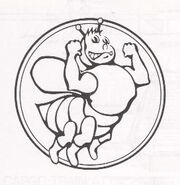
Workbee logo from the 2270s.
In the early 2270s (7 March 2215 (SFC)), Patterson-Massey Corporation were tasked with designing and constructing a grabber sled attachment. Commodore Andrew Probert came up with the initial design which was executed by Urco Galen, the project engineer at Patterson-Massey Corp.
Cargo train attachments were also in use at this time. The expandable attachment allowed the Workbee to ferry several pairs of standard cargo containers to and from starships and starbases.
By 2286, Workbees had started to be used as control cabins for drydock crane machinery. (TOS reference: Mr. Scott's Guide to the Enterprise)
24th century
By the late-24th century, Work Bees were still in use, assigned to Federation starships and starbases as part of their complement of auxiliary vessels. (ST reference: USS Enterprise Owners' Workshop Manual; DS9 reference: Star Trek: Deep Space Nine Technical Manual)
In 2372, Captain Jean-Luc Picard ordered command-level lock-outs to be installed on the Work Bee's and other auxiliaries assigned to the USS Enterprise-E. (TNG eBook: A Sea of Troubles)
In 2381, Workbees were part of Vesta-class starships auxiliary craft complement. (VOY novel: Children of the Storm)
Known craft
Deep Space 9
Among Deep Space 9's complement of workbees were 'bees 05 and 342. (DS9 reference: Star Trek: Deep Space Nine Technical Manual)
DS9 II construction site
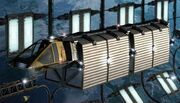
Workbee 73 at an Earth drydock in 2270.
At the Deep Space 9 (II) site, workbee 003 was one of the support craft that assembled Construction support station 173. (ST - Typhon Pact novel: Raise the Dawn)
Earth drydock
In 2270, when the Constitution-class Enterprise returned from her first five-year mission under Captain James T. Kirk, workbee 73 was one of at least eight 'bees operating in and around the drydock Enterprise was assigned to. (Ships of the Line 2012)
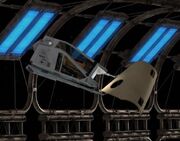
Workbee 603 assisting in the refit of the Enterprise.
Enterprise 1701 refit
Workbee 603 was one of at least fifteen 'bees assigned to the early stages of the Enterprise refit. It was also one of the few not to be colored yellow, instead being a metallic grey. (Ships of the Line 2006)
Relva VII
In 2364, 0335 was a cargo management unit assigned to Relva VII's support services. (TNG episode: "Coming of Age")
Utopia Planitia
In hangar 06 at Utopia Planitia, row upon row of workbees were parked nose to tail. These included 'bees 007, 013, 101, 123, 201, 316, 342, 345, 411, 512, 666, 906 and 909. (Ships of the Line 2012)
Specifications
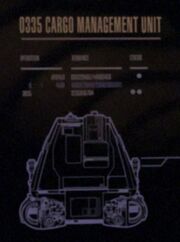
Aft view schematic of a 24th century Workbee cargo management unit.
The standard Workbee cab measured 4.11 by 1.92 by 1.90 meters, and massed 1.68 metric tonnes. It was operable by a single crewperson and could be used in pressurised or unpressurised states. (TOS reference: Mr. Scott's Guide to the Enterprise; DS9 reference: Star Trek: Deep Space Nine Technical Manual)
- The ST reference: Starship Spotter gives dimensions of 1.2m x 1.3m x 1.2m with a displacement of 2.23 metric tonnes.
23rd century
During the late-23rd century, the Workbee could provide 12 hours of full life support for its operator, although there was no artificial gravity. Two M-1020 particle beam reaction control thrusters provided the main propulsion, with small chemical fuelled thrusters for additional forward propulsion when required. Reaction control was provided by 32 pulsed laser thrusters. Running lights were positioned on the port and starboard sides, and a navigation beacon on the dorsal surface. A large shuttered headlight provided illumination for EVA operations. (TOS reference: Mr. Scott's Guide to the Enterprise; ST reference: Starship Spotter)
24th century
By the late 24th century, life support systems had been upgraded to provide for up to 15 hours of breathable gases, drinking water and cooling. Power was supplied by fuel cells and microfusion EPS which was rated for 76.4 hours. Artificial gravity was optional, although most operators preferred a null-g environment while working around large structures to minimize disorientation. 25 discrete communication channels were available for coordination of Workbee tasks. An optional astrionics package monitored the pilot's health and vital signs. If values outside of the normal range were detected, the distress beacon would activate and the Workbee would autopilot back to its docking bay. (DS9 reference: Star Trek: Deep Space Nine Technical Manual)
Attachments
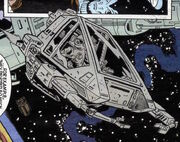
A workbee with grabber sled attachment over a spacedock.
Various attachments were available for Workbees to increase the variety of roles and assignments they could undertake.
Grabber sled
In the 2270s, a grabber sled was introduced to facilitate deep space damage repair and standard external starship maintenance amongst other tasks. The sled was constructed by the Patterson-Massey Corp and came in two versions: one with forward-facing manipulator arms and ventral grabber arms; the other without the ventral grabbers. The grabber sled was still in use in the 24th century, but sometimes called a grappler sled, the arms of which folded underneath the cockpit when not in use. (TOS reference: Mr. Scott's Guide to the Enterprise; ST reference: USS Enterprise Owners' Workshop Manual)

Cargo train in use with two pairs of standard cargo containers.
Cargo train
The cargo train attachment was capable of expanding, enabling the Workbee to transfer one or more pairs of cargo containers. This attachment could also be used for passenger modules. The frame was equipped with RCS thrusters for added maneuverability. (DS9 reference: Star Trek: Deep Space Nine Technical Manual; ST reference: Starship Spotter)
Other attachments
A welder unit and a "metal spinner" unit could also be attached to the Workbee. (ST reference: Starship Spotter)
Connections
- See also: Work Bug
External link
- Workbee article at Memory Alpha, the wiki for canon Star Trek.
